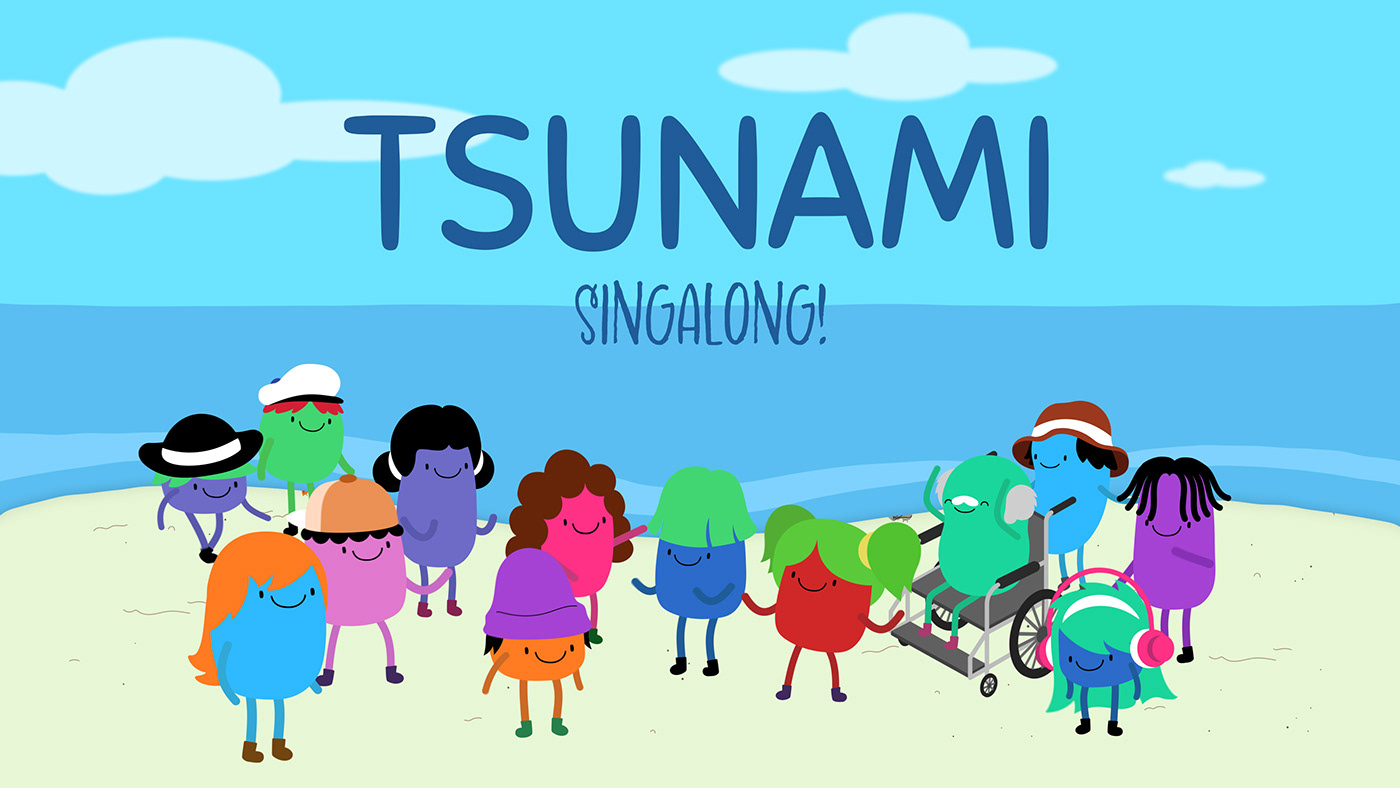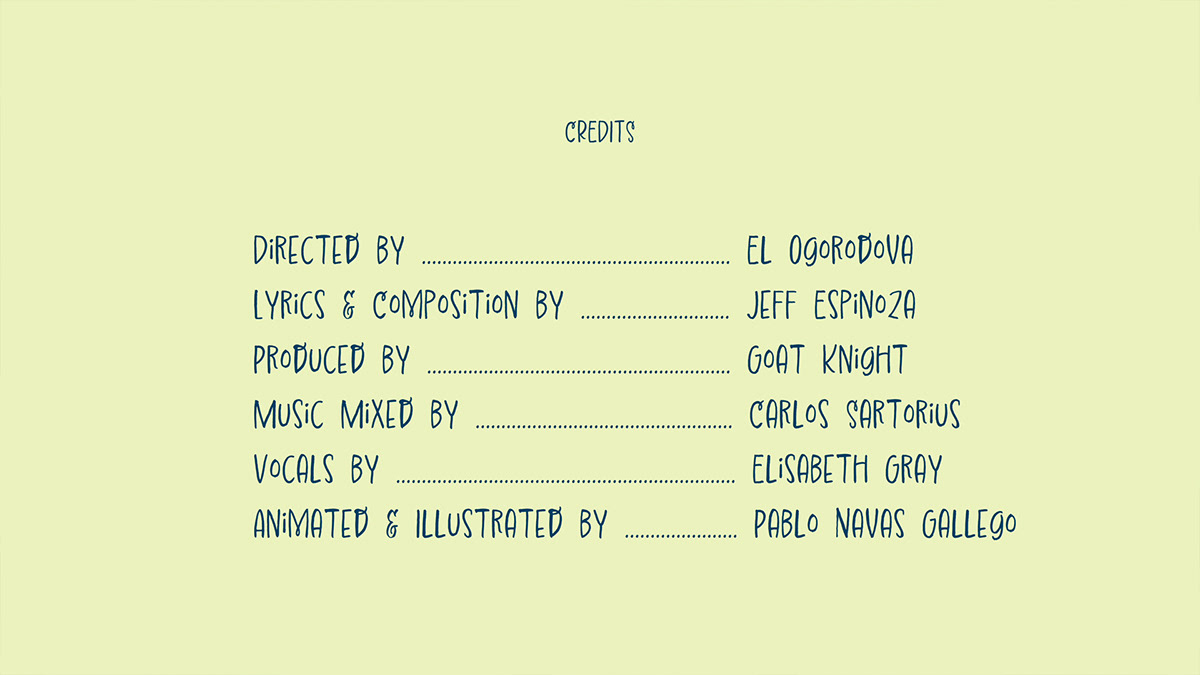The Tsunami Singalong.
An educational animated singalong for kids to learn what to do, (and not do), during a Tsunami alert.
Available in English and Spanish (Castellano).
The Tsunami Singalong was awarded a Gold prize in the 2024 Indigo Design Award competition in the Education Category. The project also won Bronze in the 2023-2024 A’ Design Award competition for Music, Audio and Sound Design.
The Tsunami Singalong premiered at the 2024 UN Ocean Decade Conference co-organized with UNESCO’s Intergovernmental Oceanographic Commission (IOC/UNESCO).

Song available in English and Spanish (Castellano)
Inspired by a science and technology documentary Goat Knight produced this year, we created an animated music video to teach children what to do (and not do) during a Tsunami alert.
The reason behind the project.
Goat Knight, produced a documentary about the tsunami risk in Southwest Europe. Ready for the Tsunami?(¿Preparados para el Tsunami?) is a 1-hour science and technology documentary that explains what causes large earthquakes and tsunamis, uncovers new historical evidence revealing their frequency, and explores world innovations that can keep us safe. After having interviewed a multitude of experts, we decided to create a singalong for kids teaching what to do and not do if a Tsunami alert happens.
According to the U.N., 40% of the world’s population lives within 100 km of the coastline (source). Education and awareness can mean the difference between life and death.
Our research on Tsunami Preparedness programs in the Iberian Peninsula made us realize that unlike in places like California, Italy, or Japan, where frequent small earthquakes are a reminder of larger ones to come, people in Southwest Europe only feel large earthquakes that happen every few decades (or even centuries). The dangerous faults off the Iberian Peninsula are about 300 km from the mainland and 4000 meters deep underwater. So, although we are living in an era during which a tsunami could occur at any moment, people are not informed to take it seriously, or even know about it.


On the left: Map from “Ready for the Tsunami?” identifying some of the main faults in Southwest Europe.
On the right: Newspaper clipping from El País about the 2021 earthquake in Granada.
Preparedness makes a huge difference. Japan is one of the most prepared countries in the world for tsunami risks. So much so that the word tsunami comes to us from the Japanese language. Science journals estimate that about 3% of the population perished in the 2011 Tōhoku earthquake and tsunami. About 18,000 people. This includes Fukushima casualties. In comparison, the 2004 Indian Ocean earthquake and tsunami resulted in an estimated 230,000 deaths. That’s 28% of the population in the risk zone. In other words, the difference between preparing and not doing so is comparable to losing 1 in 4 lives versus 1 in 30.
The 2011 5.1 Mw earthquake in Lorca (southeastern Spain), killed 9 people. People died because they didn’t know to hide under a hard surface (e.g. a table) during the quake. Those who ran outside in panic were killed by fallen debris. While “duck, cover, and hold on” is ingrained in the minds of Californians from a very young age, here in Spain, as in many other countries, it is not common knowledge, resulting in unnecessary fatalities.
There are those in Spain and Portugal who are pushing to create Tsunami awareness. Small towns are taking steps to put together Tsunami alert plans. Economists claim that for every 1 euro spent on prevention, 7 are gained in construction. Unfortunately, it’s a challenge for elected leaders to think long-term beyond electoral cycles, or for industry to think beyond quarter reports.

Scene from the Tsunami animated singalong.
We know there have been between 9 to 14 tsunamis in the past 9,000 years in the Iberian Peninsula. The great Lisbon Earthquake of 1755 is the greatest tsunami event registered in Europe (the earthquake was between 8.5 Mw and 9.2 Mw). It’s estimated that between 50,000 and 100,000 perished (in the XVIII century, a time when population density was much smaller than now). In 1908 the Messina earthquake caused a tsunami that killed an estimated 80,000 people in Italy. In 563 AD a landslide caused a lake tsunami in Geneva, Switzerland, flooding the entire old city. Although the phenomenon is infrequent, it is reoccurring. Continents move, sometimes abruptly. It’s the educational system’s responsibility to remind us of our history for a safer future.
Spain is not the only country that does not put sufficient funds into education and prevention when it comes to extreme events like tsunamis.
Education saves lives. Here is an example: A British child by the name of Tilly Smith learned about tsunamis in school. Smith recognized the signs of a tsunami when she found herself in Thailand during the 2004 Indian Ocean earthquake. Her warning saved the lives of many people who otherwise wouldn’t have known to leave the beach or evacuate to higher ground. Tilly Smith was 10 years old at the time.
The test.
We tested the Tsunami Singalong at CEIP La Inmaculada, an elementary school in Cádiz, (southern Spain). This school is particularly vulnerable to Tsunamis as it’s positioned close to the coast and stands below sea level.


Musicians Jeff Espinoza (Left) and Pablo Martín (Right) singing with students at La Inmaculada grade school in Cádiz, Spain.
The kids memorized the words quickly and enjoyed a fun and memorable learning experience. The children even made drawings of the dos and don’ts. In under 3 minutes, this group of students gained a basic understanding of how to act should they ever face a Tsunami alert in their lifetime.



Drawings by the students CEIP La Inmaculada of Cádiz, Spain. Animated by Melisa Méndez González.
The Tsunami song was created in both English and Spanish (Castellano). We hope it helps create awareness beyond Southwest Europe. If a tsunami were to ever come your way, you’ll know what to do.
Lyrics TSUNAMI (English)
A tsunami is coming
A tsunami is coming
A tsunami is coming, a tsunami is coming, a tsunami is coming our way
A tsunami is coming
A tsunami is coming, a tsunami is coming, a tsunami is coming our way
Don’t get in your car
Don’t go riding your bike
Seek the higher ground
Protect your precious life
Keep calm and stay away
from the coast, rivers and waterways
Don’t go riding your bike
Seek the higher ground
Protect your precious life
Keep calm and stay away
from the coast, rivers and waterways
(repeat chorus)
Have a plan to evacuate
to the safest place nearest you
Help others that are in need
Don’t you stop to watch or view
And when you can call your family
Listen to the tv or the radio news
to the safest place nearest you
Help others that are in need
Don’t you stop to watch or view
And when you can call your family
Listen to the tv or the radio news
(repeat chorus)
Have an evacuation plan
Keep a backpack with an emergency bag
Designate a meeting place
that’s safe for you and your family
Keep a backpack with an emergency bag
Designate a meeting place
that’s safe for you and your family
A tsunami is coming
A tsunami is coming
A tsunami is coming, a tsunami is coming, a tsunami is coming our way
A tsunami is coming
A tsunami is coming, a tsunami is coming, a tsunami is coming our way
A tsunami is coming
A tsunami is coming
A tsunami is coming, a tsunami is coming, a tsunami is coming your way
Coming your way
Coming your way
A tsunami is coming
A tsunami is coming, a tsunami is coming, a tsunami is coming your way
Coming your way
Coming your way
TSUNAMI (Spanish/Castellano)
Un tsunami viene
Un tsunami se acerca
El tsunami viene, el tsunami se acerca, el tsunami viene aquí
Un tsunami se acerca
El tsunami viene, el tsunami se acerca, el tsunami viene aquí
Hay que evitar
ir en bicicleta y coger el coche
Búscate un lugar
lejos de la costa y de ríos
Sin más, cálmate
Busca un lugar alto y protégete
ir en bicicleta y coger el coche
Búscate un lugar
lejos de la costa y de ríos
Sin más, cálmate
Busca un lugar alto y protégete
(coro)
Ten un plan para evacuar
al lugar más seguro y cercano a ti
Ayúda a los que veas mal
No te pares a curiosear
A tu familia llama en cuanto puedas
Oye las noticias en televisión
al lugar más seguro y cercano a ti
Ayúda a los que veas mal
No te pares a curiosear
A tu familia llama en cuanto puedas
Oye las noticias en televisión
(coro)
Al lugar de reunión
lleva una mochila con un botiquín
Hay que preparar un plan de acción
para emergencias y seguridad
lleva una mochila con un botiquín
Hay que preparar un plan de acción
para emergencias y seguridad
Un tsunami viene
Un tsunami se acerca
El tsunami viene, el tsunami se acerca, el tsunami viene aquí
Un tsunami se acerca
El tsunami viene, el tsunami se acerca, el tsunami viene aquí
Un tsunami viene
Un tsunami se acerca
El tsunami viene
El tsunami se acerca
El tsunami viene aquí
Viene aquí
Viene aquí
Un tsunami se acerca
El tsunami viene
El tsunami se acerca
El tsunami viene aquí
Viene aquí
Viene aquí

Credits:
Directed by El Ogorodova
Produced by Goat Knight S.L.
Lyrics and composition by Jeff Espinoza
Music mixed by Carlos Sartorius
Vocals by Elisabeth Gray
Illustration and animation by Pablo Navas Gallego
Directed by El Ogorodova
Produced by Goat Knight S.L.
Lyrics and composition by Jeff Espinoza
Music mixed by Carlos Sartorius
Vocals by Elisabeth Gray
Illustration and animation by Pablo Navas Gallego





